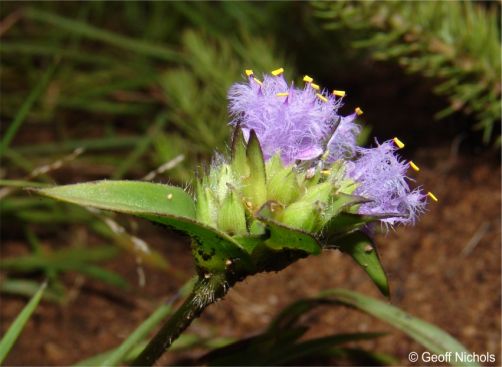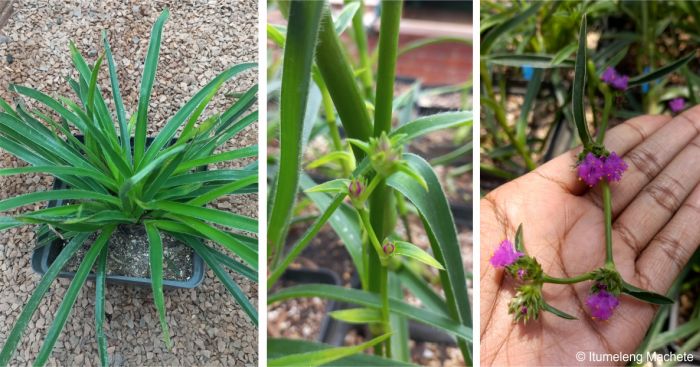Cyanotis speciosa
Cyanotis speciosa (L.f.) Hassk.
Family: Commelinaceae
Common names: doll’s powderpuff (Eng.), bloupoeierkwassie (Afr.), khopo, theepe-balingoana (seSotho), inkombo, ingonga, umakhothigobile, umakotigoyile, udabulamafu, insonga (isiZulu), ndou muhulu (tshiVenda), umagoswana (isiXhosa).
Introduction
Cyanotis speciosa is a perennial ground cover that provides all-year-round colour with its exquisite powderpuff flowers that are either blue, pink or purple. It grows naturally in grassland areas with summer rainfall and thrives in a sunny flowerbed or as a pot plant on a patio in a sunny spot.

Description
Description
Cyanotis speciosa is a perennial, herbaceous ground cover with long, thin roots and a swollen, U-shaped rhizome. It has bright green, strap-like leaves with purple sheaths. The leaves turn maroon during the cold and dry winter months. The leaves grow up to 200 mm long and 50 mm wide, and have fine, inconspicuous hairs underneath. The leaves form dense clumps up to 300 mm high. The flowers are blue, purple or pink and have densely hairy stamens and conspicuous yellow anthers. They grow on an erect flower stalk that grows up to 500 mm high. The rounded, fluffy flowers bloom all year round, providing striking colour to grassland or a water-wise garden or rockery.

Conservation Status
Status
The conservation status of Cyanotis speciosa is Least Concern (LC), according to Red List of South African Plants. This means that the plant population is stable in the wild and it is currently at low risk of extinction.
Distribution and habitat
Distribution description
Cyanotis speciosa is widespread in the summer rainfall grasslands in South Africa, occurring from the Riversdale District in the Western Cape, through the Eastern Cape into Kwa-Zulu Natal and Free State, North West, Northern Cape, Gauteng, Mpumalanga, Limpopo and all the way to Tanzania, and in Madagascar. It grows in shallow soils amongst rocks, in grassland, bushveld, fynbos and coastal areas.
Derivation of name and historical aspects
History
The genus name cyanotis comes from the Greek words kyanos, meaning ‘blue’, and ous, meaning ‘ear’, referring to the rounded, ear-like shape of the petals. The species name speciosa means ‘showy and attractive’, probably referring to the plant’s vibrant flowers.

Ecology
Ecology
Pollinating insects, especially solitary bees and butterflies, are drawn to the brightly coloured flowers.
Uses
Use
Plant Cyanotis speciosa as a ground cover in a water-wise garden, rockery or grassland garden, with a lot of sun exposure, to show off this beautiful grassland plant with vibrant flowers. It can also be used as a pot plant to liven up a sunny patio throughout the year. Cyanotis speciosa is not limited to beautifying gardens and patios, it is also used as a love charm and its roots are used to treat infertility. The Zulu people use it to break up the clouds and prevent lightning hence the name udabulamafu which means ‘cloud breaker’. It is also grazed by cattle.

Growing Cyanotis speciosa
Grow
Cyanotis speciosa can be propagated using a variety of methods, including division, seed sowing and rhizome cuttings.
Division: dig out the entire clump and separate the rhizomes into groups, ensuring that each group has at least one growing point and replant in well-drained soil. The optimal time to execute this type of propagation is in spring. Water thoroughly and keep the soil moist until the divided plants are established.
Seed propagation: the seeds do not require pre-treatment, they should be sown in a well-drained soil. Cover seeds lightly with the soil and keep the soil moist until they germinate.
Rhizome cuttings: take 5-7 cm sections of rhizomes from the mother plant in spring and plant them in a pot with well-drained soil. Keep the soil moist until roots form and new growth comes up.
References
- Ecoman, Environmenal Landscape Design Specialist. Cyanotis speciosa cv hickman. https://ecoman.co.za/green/green_docs/cyanotis_speciosa.html. Accessed 4 Jun 24.
- Hankey, A. 2021-12. Observation of Cyanotis speciosa, Johannesburg, Gauteng. iNaturalist. Online. https://www.inaturalist.org/observations/102770109.
- Helme, N. 2024-02. Observation of Cyanotis speciosa, Sekhukhune, Limpopo. iNaturalist. Online. https://www.inaturalist.org/observations/201347451.
- Hyde, M.A., Wursten, B.T., Ballings, P. & Coates Palgrave, M. 2024. Cyanotis speciosa subsp. speciosa. Flora of Zimbabwe. Online. https://www.zimbabweflora.co.zw/speciesdata/species.php?species_id=112930. Accessed 4 Jun 24.
- Manning, J. & Goldblatt, P. 2012. Plants of the Greater Cape Floristic Region 1: the Core Cape Flora. Strelitzia 29. South African National Biodiversity Institute, Pretoria.
- Pooley, E. 1998. A field guide to wild flowers of Kwazulu-Natal and the eastern region. Natal Flora Publications Trust, Durban.
- Raimondo, D., Von Staden, L., Foden, W., Victor, J.E., Helme, N.A., Turner, R.C., Kamundi, D.A. & Manyama, P.A. (eds) 2009. Red list of South African plants. Strelitzia 25. South African National Biodiversity Institute, Pretoria.
Credits
Itumeleng Machete and Thabiso Chester Chauke
Pretoria National Botanical Garden
July 2024
Acknowledgements: the authors thank Andrew Hankey, Nick Helme and Geoff Nichols for the pictures.
Plant Attributes:
Plant Type: Ground Cover, Perennial
SA Distribution: Eastern Cape, Free State, Gauteng, KwaZulu-Natal, Limpopo, Mpumalanga, North West, Northern Cape, Western Cape
Soil type: Sandy, Loam
Flowering season: Sporadic/All year
PH:
Flower colour: Blue, Purple, Pink, Mauve/Lilac
Aspect: Full Sun, Afternoon Sun (Semi Shade)
Gardening skill: Easy
Special Features:
Horticultural zones










Rate this article
Article well written and informative
Rate this plant
Is this an interesting plant?
Login to add your Comment
Back to topNot registered yet? Click here to register.